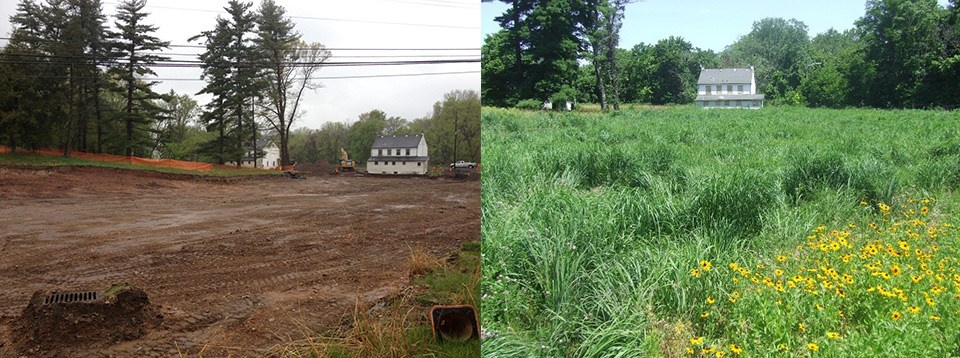
OverviewThe Asbestos Release Site (Site) refers to an area located in the center of Valley Forge National Historical Park that became contaminated by activities of a manufacturing company formerly located on the property. NPS is currently completing a long-term remedial action under the Comprehensive Environmental Response, Compensation, and Liability Act (CERCLA), also known as Superfund, to clean up the contamination that had resulted from these activities. The entire Site will be re-opened for public use when the vegetation which was planted as part of the clean-up is sufficiently established. HistoryIn the 19th century, limestone located in the area around the Site was quarried to be used as a soil amendment in agriculture. From 1877 to 1895, Ehret Magnesia Company (Ehret) purchased many of the quarries and until 1968, Ehret and later Baldwin-Ehret-Hill manufactured asbestos-containing insulation products at a plant located in a former quarry adjacent to County Line Road. The manufacturing process included combining asbestos fibers imported from Canada with magnesium carbonate obtained from the limestone quarries. Ehret disposed of the slurry waste generated during the manufacturing process into the quarries and a channel that eventually discharged into a tributary to the Schuylkill River. The Baldwin-Ehret-Hill company was acquired by Keene Corporation in 1968. Keene did not manufacture asbestos-containing materials at the plant but did continue to sell the products. The Keene plant closed in the early 1970s. Some of the quarries used for waste disposal by Ehret became part of Valley Forge State Park after it was established by the Commonwealth of Pennsylvania in 1893 to preserve lands used by the Continental Army during its 1777-1778 winter encampment. The state park was transferred to the National Park Service (NPS) and was established as Valley Forge National Historical Park in 1976. Land acquired by the United States for establishment of the park included contaminated land that was formerly part of Valley Forge State Park as well as the adjacent privately owned 46-acre parcel where the inactive Ehret manufacturing plant was located. In the late 1970s, the NPS removed all buildings associated with the former Ehret manufacturing plant. Asbestos Release Site Clean-upNPS discovered buried asbestos-contaminated soil in 1997 during the excavation of a trench for a fiber optic cable. To address the immediate risk to the public that could have been posed by a potential airborne release of asbestos from contaminated soil, the U.S. Environmental Protection Agency (EPA) and NPS initiated an emergency response. Activities completed during the emergency response addressed the immediate risk to the public by covering areas with clean soil and installing warning fences and signs to prevent public access to all potentially contaminated areas. In 1999, NPS and the Commonwealth entered into an agreement that stipulated that the Commonwealth, under NPS direction and oversight, would complete a CERCLA Remedial Investigation and Feasibility Study (RI/FS) for the Site. The results of the RI/FS investigation, completed in 2005, identified nine areas that contained levels of contaminants including asbestos, semivolatile organic compounds (specifically polycyclic aromatic hydrocarbons, and three metals (lead, mercury, and arsenic) that may cause unacceptable risks to humans and/or ecological receptors. Based on the results of the RI/FS, NPS identified a possible remedy for the Site that would address all contamination located within two feet of the ground surface. After a formal public comment period, NPS chose this remedy and presented it in the Record of Decision (ROD) issued for the Site on January 18, 2007. In spring 2010, the Commonwealth and the U.S. government reached a cost-sharing agreement and dedicated funds for the Site’s cleanup. In 2012, after preparation of a remedial design that provided the specific steps to be taken to clean up the Site, NPS procured a contractor and in 2013-2014 began the field work necessary for cleanup. As stipulated by the ROD, as each area defined in the remedial design was addressed, NPS collected soil samples to ensure that all contamination located within the top two 2 feet of soil had been removed. Results from analysis of these samples indicated that additional contamination remained within the top two feet of soil within discrete areas of the Site. In 2015, NPS delineated the extent of these areas; and cleanup was completed in the fall of 2017. In March 2018, NPS completed an inspection of the Site to ensure the cleanup effectively achieved the desired result of removing risk posed by contaminated soil located within two feet of the ground surface. During this inspection, NPS observed the presence of asbestos-containing slurry at the ground surface within the root systems of trees likely uprooted during a storm event within an area of the Site identified as the Cave Quarry. Asbestos-containing slurry remains in this area two feet below the ground surface because it had been determined to not pose a risk to human health or ecological receptors at this depth. To effectively remove the ongoing risk that additional trees located in the Cave Quarry may be toppled in the future, NPS will remove all trees and cover the entire area with two feet of soil. In fall 2018, NPS began replanting other areas of the ARS where the plantings did not survive the winter season and additional planting and vegetation management are ongoing. The entire Site will be re-opened for public use as soon as areas replanted with trees and meadow grasses as part of the cleanup are sufficiently established. On April 30, 2020, the United States Environmental Protection Agency (EPA) announced that Valley Forge National Historical Park (NHP) is the 2020 recipient of the Federal Facility Excellence in Site Reuse Award. This is a national award that recognizes innovative thinking and cooperation among federal agencies, states, tribes, local partners, and developers that have led to noteworthy restoration and reuse of federal facility sites. For a more detailed discussion on the history of the Site and CERCLA investigations completed please see the documents provided at the links below: 
NPS Graphic More InformationAmy Ruhe |
Last updated: January 23, 2025
